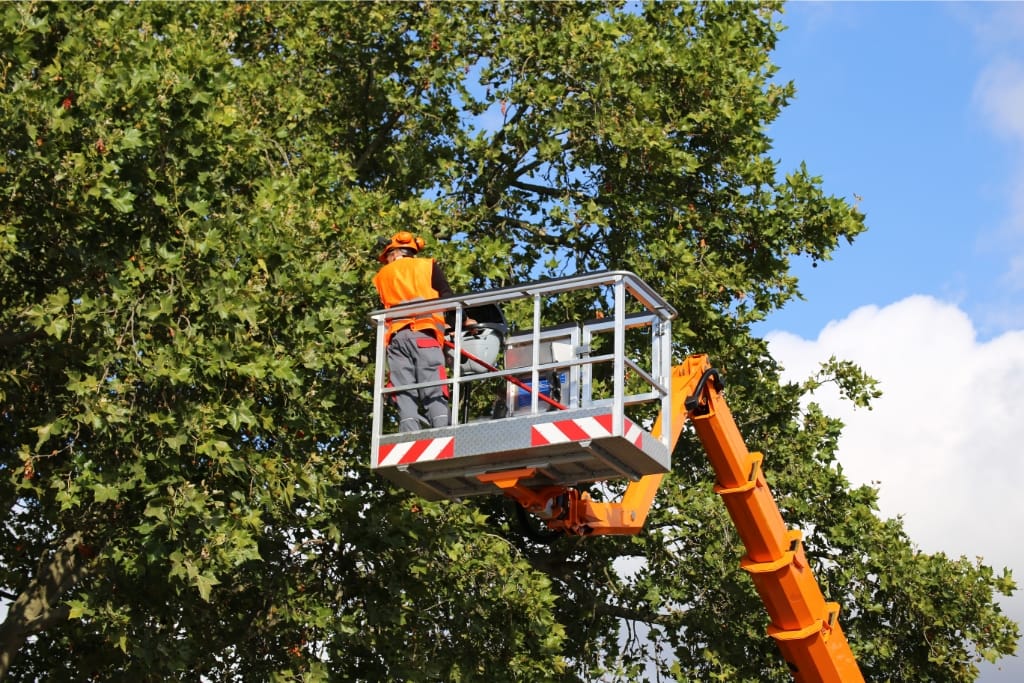Caring for the trees in your yard is one of the most rewarding ways to enhance both your property's value and aesthetic appeal.
Trees provide shade, improve air quality, and create a welcoming habitat for local wildlife.
However, understanding proper tree care is essential to ensure they thrive for generations.
Discover the essential tips to maintain healthy and vibrant trees with ease, and learn how you can be an effective steward of your urban forest.
Let's explore practical techniques and expert advice that will keep your trees in great shape year-round.
1)) Choose The Right Tree For Your Space
Selecting the right tree for your space is the cornerstone of successful tree care.
When choosing a tree, consider factors such as the local climate, soil type, and the amount of sunlight the area receives.
Trees have specific requirements and limitations, and aligning these with your environment will help ensure a healthy growth trajectory.
It's important to think about the tree's mature size to avoid issues with overcrowding, interference with power lines, or disruption to your home's structure.
Consult with local nurseries or arborists to find species that are well-suited for your location and desired aesthetic.
By carefully selecting the right tree, you lay the foundation for a thriving addition to your landscape.
2)) Properly Plant Your Tree
Properly planting your tree is crucial for its long-term health and development.
Begin by selecting a planting site that accommodates the tree's mature size and provides ample space for root expansion.
Dig a hole that is twice as wide as the root ball but no deeper than the root ball itself to encourage proper root growth.
Gently place the tree into the hole, ensuring that the root flare is at ground level.
Backfill the hole with native soil, avoiding the temptation to amend excessively, which can hinder root establishment.
Water the tree thoroughly to eliminate air pockets, and apply a layer of organic mulch around the base to conserve moisture and regulate soil temperature.
With these steps, you set the stage for your tree to flourish and add lasting beauty to your surroundings.
3)) Watering Guidelines For Young And Mature Trees
Understanding proper watering guidelines is pivotal to nurturing both young and mature trees.
Young trees, still establishing their root systems, require more frequent watering to ensure they develop strong roots and reach for nutrients.
Aim to water deeply, soaking the soil down to a depth of at least 12 inches, and do so regularly, especially during dry spells.
On the other hand, mature trees have more extensive root systems and are generally more drought-tolerant.
They benefit from less frequent, but deep and thorough watering, which typically suffices once every one to two weeks, depending on weather conditions.
Consider installing a soaker hose or drip irrigation system to deliver water efficiently while minimizing waste.
By adhering to these watering guidelines, you give your trees the hydration they need to remain resilient and vibrant through changing seasons.
4)) Importance Of Mulching
Mulching is an invaluable practice in tree care, offering numerous benefits that contribute to healthier and more robust trees.
By applying a layer of organic mulch, such as wood chips or shredded bark, around the base of your trees, you can significantly improve soil quality and moisture retention.
Mulch acts as an insulating layer, conserving soil moisture by minimizing evaporation and keeping roots cooler during hot weather.
It also suppresses weed growth, reducing competition for nutrients and water.
As the mulch decomposes, it enriches the soil with organic matter, further benefiting root health.
To maximize the effectiveness of mulching, apply a layer of 2 to 4 inches thick, beginning a few inches away from the trunk to prevent moisture-induced rot.
Through consistent mulching, you foster a supportive environment for your trees, enhancing their vitality and long-term resilience.
5)) Fertilizing For Tree Health
Fertilizing is a critical component in promoting tree health, providing essential nutrients that support vigorous growth and overall vitality.
Healthy trees may require minimal fertilization, but those in nutrient-poor soils or under stress benefit significantly from targeted nutrient supplements.
Begin by conducting a soil test to identify deficiencies and understand specific needs.
Use a balanced, slow-release fertilizer to ensure a steady supply of nutrients without the risk of leaching or damaging the tree's roots.
The best time to fertilize is during the tree's active growing season, either in early spring or late fall, to align with natural growth rhythms.
Avoid excessive fertilization, as this can lead to nutrient imbalances or environmental harm.
By following these fertilizing guidelines, you provide your trees with the necessary nourishment to maintain robust health and withstand environmental challenges.
6)) Pruning Techniques And Timing
Proper pruning techniques and timing are vital to sustaining tree health and ensuring structural integrity.
Pruning encourages the growth of strong, well-spaced branches by removing dead, diseased, or broken limbs, and it enhances air circulation throughout the canopy.
The timing of pruning is crucial: the best general period is during the dormant season in late winter or early spring, before new growth signals tree activity.
For flowering trees, prune just after their blooms fade to promote the next season's growth.
Use sharp, clean tools to make precise cuts at the branch collar to aid healing and deter disease.
Avoid cutting too many branches at once, as this can lead to stress and vulnerability.
With careful pruning and attention to timing, you enhance a tree's aesthetic form while promoting sustainable growth and maintaining the health and safety of your landscape.
7)) Recognizing And Managing Pests And Diseases
Recognizing and managing pests and diseases in trees is an essential aspect of effective tree care, contributing to the longevity and health of your landscape.
Early detection is key, so regularly inspect trees for signs of infestation or disease, such as discolored leaves, unusual growth, or visible insect presence.
Utilize integrated pest management strategies, combining physical, biological, and chemical controls, to mitigate damage sustainably.
Encourage natural predators, like birds and beneficial insects, to control pest populations, and only resort to chemical treatments when necessary, selecting targeted options that minimize harm to non-target species and the environment.
Regularly scheduled check-ups and preventive measures, such as proper watering, fertilizing, and pruning, strengthen trees' natural defenses.
Through vigilant monitoring and appropriate interventions, you safeguard the health and aesthetic appeal of your trees, ensuring their continued vitality in the face of potential threats.
8)) Protecting Trees From Extreme Weather
Extreme weather conditions pose significant threats to trees, necessitating proactive measures to ensure their protection and survival.
During periods of severe weather, such as storms, droughts, or extreme cold, trees can suffer from broken branches, root damage, or dehydration.
One effective strategy is to facilitate proper tree hydration through deep, infrequent watering before expected drought conditions, which helps maintain soil moisture and tree health.
Mulch can regulate soil temperature and moisture levels, playing a crucial role in protecting roots during temperature extremes.
For heavy storm protection, prune trees to remove weak or overhanging branches and reduce canopy density, which minimizes wind resistance and potential damage.
Support vulnerable trees with stakes during intense weather periods to ensure stability, but avoid leaving them in place long-term.
By implementing these protective strategies, you enhance your trees' resilience against extreme weather events, ensuring their longevity and thriving contribution to your environment.
9)) Dealing With Tree Root Issues
Tree root issues can present significant challenges, impacting both tree health and surrounding landscapes.
Roots often seek out water and nutrients, occasionally disrupting sidewalks, building foundations, or underground utilities.
Addressing root issues begins with proper planting practices, ensuring trees have ample space to grow without interference.
If root conflict arises, carefully consider alternatives to cutting, such as rerouting sidewalks, using root barriers, or opting for less invasive landscaping.
If roots must be cut, proceed cautiously to minimize damage to the tree's stability and health.
Never remove more than one-third of the roots at any time, as this can severely stress or kill the tree.
Regular assessment of tree roots, combined with informed remedial actions, can mitigate potential problems, preserving the health of both trees and their surrounding environments.
10)) Caring For Newly Planted Trees
Proper care for newly planted trees is critical to establish strong roots and ensure vigorous growth.
Start by choosing an appropriate location with adequate sunlight, soil drainage, and space for growth, as these factors are essential for a tree's long-term health.
After planting, provide consistent watering to help the tree acclimate, ensuring the root ball remains moist but never waterlogged.
Applying a layer of mulch around the base helps retain moisture, regulate soil temperature, and deter weeds.
Be cautious with fertilization: too much can harm a developing root system.
Support young trees with stakes only if necessary, and remove them once the tree can stand independently to prevent girdling.
Monitor for signs of pests or diseases, addressing any issues promptly.
Through attentive care and patience during a tree's early stages, you lay the foundation for a robust, flourishing member of your landscape for years to come.
11)) Monitoring Tree Growth And Structure
Monitoring tree growth and structure is a crucial aspect of maintaining a healthy and beautiful landscape.
Regular assessments help identify potential problems early, allowing for timely interventions that can prevent long-term damage to the tree.
Focus on evaluating the tree's size, shape, and condition to ensure it is growing symmetrically and remains structurally sound.
Pay attention to anomalies such as irregular branching, dieback, or signs of stress, which could indicate underlying issues.
Implement corrective measures like strategic pruning, which can promote a balanced canopy and remove compromised limbs, thereby enhancing overall stability and health.
Keeping a detailed record of growth patterns and changes over time aids in planning future care and interventions.
Through consistent observation and maintenance, you ensure trees grow safely and healthily, enriching the landscape and contributing to a sustainable environment.
12)) Consulting Professional Arborists When Needed
Enlisting the expertise of professional arborists can be invaluable when dealing with complex tree issues that require specialized knowledge and skills.
Arborists are trained to assess tree health, diagnose diseases, and provide tailored care recommendations that go beyond basic maintenance.
Their expertise is particularly beneficial when addressing issues such as severe structural problems, pest infestations, or nutrient deficiencies that may not be easily identifiable by an untrained eye.
Professional arborists can also offer guidance on selecting appropriate tree species for specific landscapes and ensuring proper planting techniques to avoid future complications.
By consulting an arborist, you gain access to a wealth of knowledge that can safeguard your trees' health and vitality.
When in doubt about the well-being of your trees or when dealing with substantial tree-related concerns, seeking an arborist's advice ensures informed decision-making and promotes a thriving, well-maintained environment.
Conclusion
Maintaining healthy trees is a multifaceted endeavor that enriches our landscapes and benefits the environment.
From understanding and addressing root issues to ensuring proper care for newly planted trees, each step plays a vital role in sustaining tree health and longevity.
Regular monitoring and attentive care, coupled with the wisdom of professional arborists when necessary, create a strong foundation for thriving trees.
By investing in these practices, we not only enhance the aesthetic appeal of our surroundings but also contribute to ecological balance, supporting biodiversity and combating climate change.
A commitment to responsible tree care is an investment in a greener future, promoting the well-being of our planet and the enjoyment of its natural beauty for generations to come.
Download Our Free E-book!








